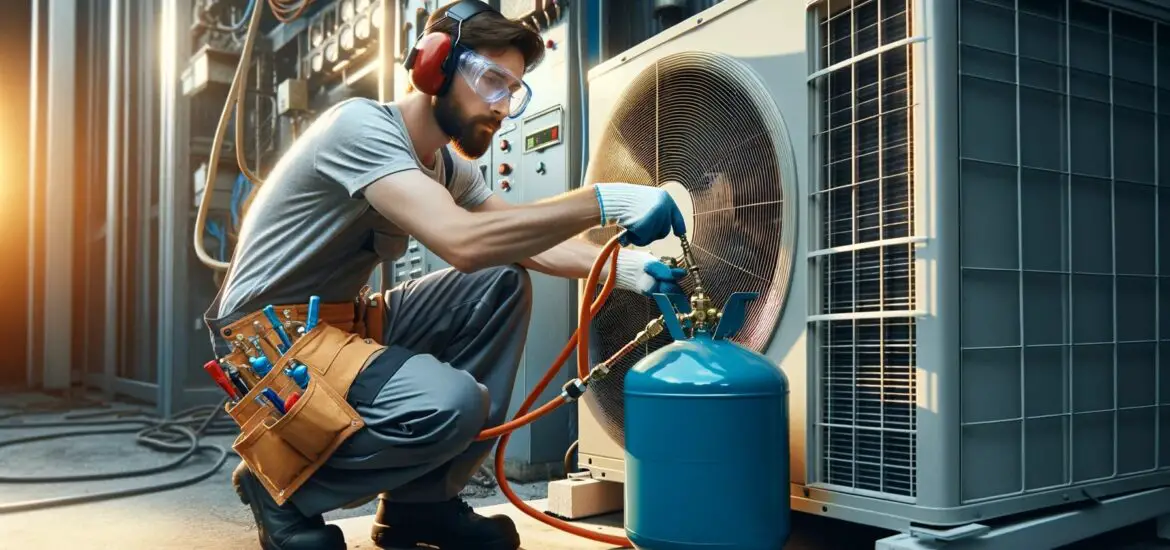This article will guide you through the process of adding freon when compressor is off to your air conditioning unit.

Table of Contents
Safety Precautions
Working with Freon and air conditioning systems demands a high level of care to ensure personal and environmental safety. Here are detailed safety measures you should follow:
Well-Ventilated Area: Always work in a well-ventilated space to avoid inhaling Freon, which can be harmful to your health.
Wear Protective Gear: Use safety gloves resistant to chemicals to protect your hands from Freon. Safety goggles are also essential to protect your eyes from any accidental splashes.
Handle Freon Responsibly: Freon should be handled with care as it can be harmful to the environment. Ensure any leftover Freon or containers are disposed of in accordance with local regulations.
Check for Legal Compliance: In many regions, handling Freon requires certification due to its environmental impact. Ensure you are legally allowed to handle Freon or seek assistance from a certified professional.
Read Your AC’s Manual: Familiarize yourself with your AC’s specifications and safety recommendations as outlined in the user manual. This knowledge is crucial for safe operation.
Electrical Safety: Ensure that the AC unit is powered off before you begin work to avoid the risk of electrical shock.
Remember, if you’re ever in doubt about handling Freon or the safety procedures, it’s safer to consult with a professional technician.
Tools and Materials Needed
Having the right tools and materials is crucial. You will need:
Freon: The specific type required for your AC system, as stated in your manual.
Manifold Gauge Set: This tool measures the pressure of the refrigerant within your system and is essential for safely adding Freon. You can get this BENTISM 4-Way AC Manifold Gauge Set from Walmart.
Protective Gear: Safety gloves and goggles.
A/C System User Manual: For specific details about your system.
Step-by-Step Process of Adding Freon When Compressor is Off
This section walks you through the process of adding Freon when compressor is off, detailing each step for clarity:
Identifying the Correct Refrigerant Type: Check your AC manual to identify the specific type of Freon required. Using the wrong type can lead to inefficiency or damage to the system.
Attaching the Manifold Gauge Set: This tool has three ports: low pressure (blue), high pressure (red), and service (yellow). Connect the blue hose to the low-pressure service port and the red hose to the high-pressure service port on your AC. The yellow hose will be used to add Freon.
Checking System Pressure: With the compressor off, look at the pressure readings on the gauges. Compare these readings to the recommended levels in your manual. If the pressure is too low, it indicates a need for additional Freon.
Adding Freon: Connect the yellow hose to the Freon container. Open the valve on the Freon supply carefully, allowing the refrigerant to flow into the system. Continuously monitor the gauge to ensure you don’t overfill the system. Add Freon slowly to prevent sudden pressure changes.
Checking for Leaks: After adding Freon, use a leak detector or soapy water around the connections to check for leaks. Bubbles forming indicate a leak which must be fixed to prevent refrigerant loss.
Throughout this process, it’s crucial to follow your AC’s specific guidelines and keep an eye on the gauges to maintain the correct pressure levels.
Final Checks and Testing
After you’ve added Freon, it’s important to check if the system is functioning correctly:
Turn On the AC: Power on your AC unit and let it run for a few minutes. This allows the Freon to circulate and stabilize within the system.
Monitor Cooling Efficiency: Check if the air coming from the AC is cooler than before. It’s a good sign if the air is noticeably cooler.
Listen for Unusual Noises: Pay attention to any strange sounds from the AC unit. Noises like hissing or banging can indicate a problem with the system.
Re-check for Leaks: After the system has been running for a while, re-check for any potential leaks.
Observe the Compressor: Ensure that the compressor kicks in and operates smoothly without interruptions or unusual noises.
If the system isn’t cooling properly or if you notice any other issues, it’s advisable to consult a professional technician for further diagnostics and repair.
When to Seek Professional Help
If at any point you feel uncertain or if the process seems too complex, don’t hesitate to contact a professional. Regular professional maintenance can help prevent issues and extend the lifespan of your system.
